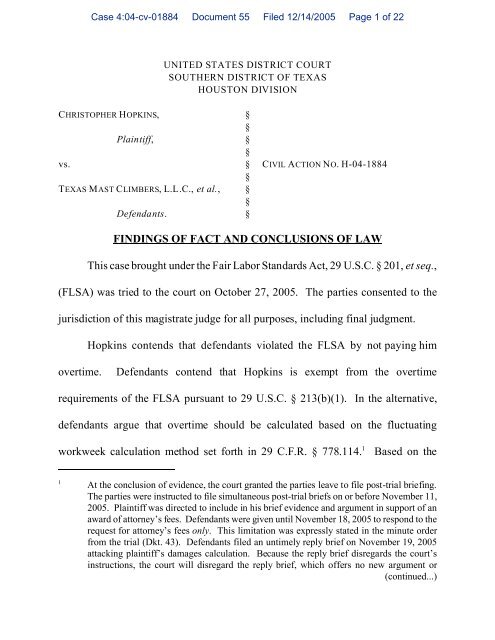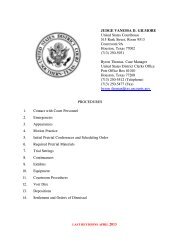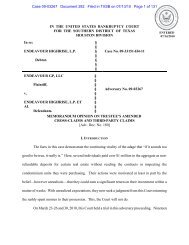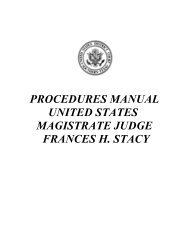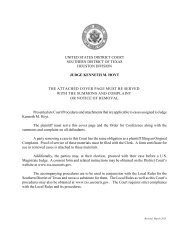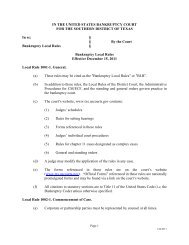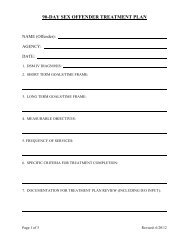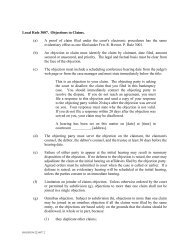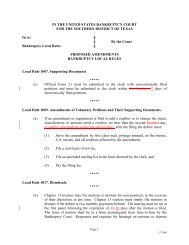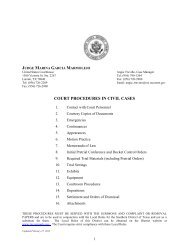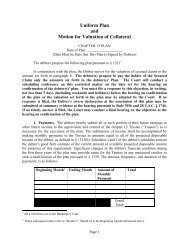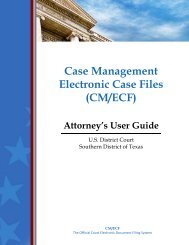FINDINGS OF FACT AND CONCLUSIONS OF LAW This case ...
FINDINGS OF FACT AND CONCLUSIONS OF LAW This case ...
FINDINGS OF FACT AND CONCLUSIONS OF LAW This case ...
You also want an ePaper? Increase the reach of your titles
YUMPU automatically turns print PDFs into web optimized ePapers that Google loves.
Case 4:04-cv-01884 Document 55 Filed 12/14/2005 Page 1 of 22UNITED STATES DISTRICT COURTSOUTHERN DISTRICT <strong>OF</strong> TEXASHOUSTON DIVISIONCHRISTOPHER HOPKINS, §§Plaintiff, §§vs. § CIVIL ACTION NO. H-04-1884§TEXAS MAST CLIMBERS, L.L.C., et al., §§Defendants. §<strong>FINDINGS</strong> <strong>OF</strong> <strong>FACT</strong> <strong>AND</strong> <strong>CONCLUSIONS</strong> <strong>OF</strong> <strong>LAW</strong><strong>This</strong> <strong>case</strong> brought under the Fair Labor Standards Act, 29 U.S.C. § 201, et seq.,(FLSA) was tried to the court on October 27, 2005. The parties consented to thejurisdiction of this magistrate judge for all purposes, including final judgment.Hopkins contends that defendants violated the FLSA by not paying himovertime. Defendants contend that Hopkins is exempt from the overtimerequirements of the FLSA pursuant to 29 U.S.C. § 213(b)(1). In the alternative,defendants argue that overtime should be calculated based on the fluctuatingworkweek calculation method set forth in 29 C.F.R. § 778.114. 1 Based on the1At the conclusion of evidence, the court granted the parties leave to file post-trial briefing.The parties were instructed to file simultaneous post-trial briefs on or before November 11,2005. Plaintiff was directed to include in his brief evidence and argument in support of anaward of attorney’s fees. Defendants were given until November 18, 2005 to respond to therequest for attorney’s fees only. <strong>This</strong> limitation was expressly stated in the minute orderfrom the trial (Dkt. 43). Defendants filed an untimely reply brief on November 19, 2005attacking plaintiff’s damages calculation. Because the reply brief disregards the court’sinstructions, the court will disregard the reply brief, which offers no new argument or(continued...)
Case 4:04-cv-01884 Document 55 Filed 12/14/2005 Page 2 of 22evidence presented at trial and applicable law, the court makes the following findingsof fact and conclusions of law. 2I. <strong>FINDINGS</strong> <strong>OF</strong> <strong>FACT</strong>1. Defendant William F. Mims, Jr. is the sole owner of defendant MastClimbers Manufacturing, Inc. d/b/a American Mast Climbers (collectively “MastClimbers”). Mims also owns Texas Mast Climber L.L.C., a holding company thatowns equipment used by Mast Climbers.2. Mast Climbers rents and assembles elevating work platforms,scaffolding, mast climbing platforms, hoists, and various construction equipment.3. Defendant AMS Staff Leasing handles payroll functions for MastClimbers. Although AMS is the name that appears on Hopkins’s checks, Hopkins hasnever talked to anyone with AMS and does not know where the company is located.AMS had no control over Hopkins’s work.1(...continued)authority in any event.In addition, defendants’ post-trial briefing relies on evidence not admitted at trial, specificallythe results of a wage and hour investigation conducted by the Department of Labor. Thecourt does not consider the Department of Labor investigation in reaching its decision.2To the extent any item designated as a finding of fact is actually a conclusion of law, it isadopted as such and vice versa.2
Case 4:04-cv-01884 Document 55 Filed 12/14/2005 Page 3 of 224. Hopkins worked for Mast Climbers from April 16, 2003 through June18, 2003 and again from September 23, 2003 through April 3, 2004, a total of 37weeks. Hopkins’s primary job responsibility was to erect and dismantle scaffolding,hoists, and related equipment. He worked on various construction projects in Texasand Louisiana.5. Mast Climbers’ scaffolding equipment was kept at its “yard” in FortWorth for delivery by truck to job sites. Sometimes equipment was trucked from onejob site to another without returning to Fort Worth.6. Mims worked, and during the period at issued lived, out of MastClimbers’ office in Fort Worth. Mims was not on the job sites all the time, and in factat times did not know where Hopkins was working. He saw Hopkins on average onceor twice a month.7. Hopkins, a Houston resident, was rarely in Fort Worth. For that reason,it was not a usual part of his job to load trucks with scaffolding equipment fordelivery to a job site. A daily work report indicates that Hopkins assisted withloading 8 ½' tie-pipes onto a pickup truck at the Fort Worth facility on March 3,2004. That truck was driven to a job site in Dallas. That is the only evidence in therecord of Hopkins performing loading activities at the Fort Worth equipment yard.3
Case 4:04-cv-01884 Document 55 Filed 12/14/2005 Page 4 of 228. Hopkins worked as part of a two-man crew with his supervisor, DennisDan. Hopkins did not at any relevant time have a driver’s license. Therefore, it wasthe usual practice for Hopkins to ride to job sites in a pickup truck driven by Dan,who would pick up Hopkins at his residence in Houston. On two or three occasionsHopkins drove the pick-up truck home from a job site because they had worked longhours and Dan could not stay awake.9. Small tools and equipment necessary for the job were transported in thepickup truck. Dan loaded tools into the truck before picking up Hopkins.Occasionally, equipment such as pipes, a welding machine, or parts and pieces of atower, would need to be shuttled between job sites using the pickup truck. AlthoughMims testified that this was a routine practice, there is no evidence that Hopkinshimself ever loaded a pickup truck for this purpose.10. Dan and Hopkins filled out time sheets, daily reports, and service andinspection reports to keep track of the work they performed at job sites. It was Dan’sjob to make sure these reports were faxed to Mims in Fort Worth.11. After completion of a job, the equipment would be loaded for return tothe yard or transport to another job site. Hopkins worked primarily with a MastClimbers truck driver named Dustin Bushnell, although he recalls working a fewtimes with a driver named Pete. On a very large job, many trucks might be required4
Case 4:04-cv-01884 Document 55 Filed 12/14/2005 Page 5 of 22to remove all of the equipment from the job site. In that <strong>case</strong>, Mims would hire acommercial trucking company.12. Loading a truck at a job site was a three man operation. Dan wasresponsible for driving the forklift and putting the equipment on the truck. The truckdriver, usually Dustin, would supervise and ensure proper placement of theequipment. Hopkins would assist by moving the equipment for Dan to pick up andby directing traffic. On the few occasions when Hopkins assisted in loading a truckafter a job was completed, he placed equipment on the truck at the direction of thetruck driver and exercised no discretion. Mims acknowledged that during the timeHopkins worked with Dan, it was Dan’s responsibility to know how to load thetrucks.13. Mims was not routinely on the job site with Dan and Hopkins. Hisknowledge of what went on at the job site is based on his review of the daily reports.Mims does not have any personal knowledge of how or by whom trucks were loadedat job sites in Louisiana.14. Mims was present for the tear-down of a very large job in the Houstonarea known as Intrepid Stone. Mast Climbers’ equipment was on that job site forapproximately 18 months. During the tear-down, which lasted 4 or 5 days, Mimspersonally drove the forklift to load the trucks. He recalls Hopkins working5
Case 4:04-cv-01884 Document 55 Filed 12/14/2005 Page 6 of 22alongside him, but Hopkins did not drive the forklift or actually place equipment ona truck during that job.15. Dan stopped working for Mast Climbers less than 30 days beforeHopkins was terminated. After Dan left, Hopkins worked with Adam Martin. Again,because Hopkins did not have a driver’s license, Martin drove the pickup truck andtook over the job of faxing time sheets and daily reports to Fort Worth. Hopkins wasthe senior member of the crew, but was never actually promoted to supervisor. Thereis no evidence that Hopkins loaded a truck, either at a job site or in Fort Worth,during the brief period of time after Dan left Mast Climbers and Hopkins wasterminated.16. Mims acknowledged that it was not unusual for Hopkins to work inexcess of 50 hours per week. If a job was out of town, the crew would work longhours for as many days as necessary to get the job done and head home. Hopkinsgenerally worked six days per week and took off very few days. Hopkins estimateshe worked an average of 65 hours per week during his 37 weeks of employment.Mast Climbers offered no evidence to the contrary.17. Records produced by Mast Climbers indicate that Hopkins worked over40 hours in at least 20 of those weeks. However, there are many days unaccountedfor by Mast Climbers’ records. Hopkins testified that he worked several days for6
Case 4:04-cv-01884 Document 55 Filed 12/14/2005 Page 7 of 22which there are no time records, including six hours on December 25, 2004. Hopkinsdid not keep copies of his time sheets, and therefore cannot remember exactly whichdays he worked. Hopkins found three time sheets covering the weeks from March8 through March 28, 2004 in the pickup truck after his termination on April 3, 2004,which he produced to counsel but which were not produced by Mast Climbers. Mimsdid not handle any payroll functions and does not know why there are gaps in therecords.18. For the nine-week period from April 16, 2003 through June 18, 2003,Mast Climbers paid Hopkins $866.67 twice a month. For the 21-week period fromSeptember 23, 2003 through February 15, 2004, Mast Climbers paid Hopkins $960.00twice a month. For the seven-week period from February 16, 2004 through April 3,2004, Mast Climbers paid Hopkins $1,083.33 twice a month. Mast Climbers paidHopkins the same amount no matter how many hours he worked in a week.19. Before he was hired on April 16, 2003, Dan told Hopkins that he wouldbe paid between $430 and $450 per week, based on a 40 hour workweek. There wasno discussion of overtime.20. Hopkins was given an employee handbook when he was initially hiredby Mast Climbers. The handbook indicates that work-time for field personnel wasfrom 6:00 am until 3:30 pm, Monday through Friday, with 30 minutes for lunch.7
Case 4:04-cv-01884 Document 55 Filed 12/14/2005 Page 8 of 22Employees were also expected to be on call on weekends on a rotating basis.Weekend hours for on-call employees were Saturday from 6:00 am until noon, withlonger hours in <strong>case</strong> of an emergency. The handbook does not contradict Hopkins’sassertion that his salary was intended to cover a 40 hour workweek.21. Before starting work the second time, Hopkins talked to Dan about hissalary and hours. Dan offered Hopkins more money to return to work. Even thoughhe had worked more than forty hours per week during his first period of employment,Hopkins believed Dan when he said that Hopkins would be paid based on a 40 hourweek, 3 and that overtime was not expected. Hopkins accepted the offer to return toemployment with Mast Climbers because he needed the money and enjoyed the work.Mims never spoke with Hopkins about his salary or overtime, and does not knowwhat was said in the conversations between Hopkins and Dan. Dan did not testify attrial.22. Hopkins’s last day of work for Mast Climbers was April 3, 2004.3Although Mast Climbers disputed at trial that Hopkins was paid based on a 40 hour week,Mast Climbers submitted as part of the Joint Pretrial Order a proposed finding of fact thatfor each period of employment Hopkins was paid a salary on a semi-monthly basis thatequated to a specific hourly rate “for a forty-hour work week.” Defendants’ proposedfindings of fact and conclusions of law (Dkt. 39), 13.8
Case 4:04-cv-01884 Document 55 Filed 12/14/2005 Page 9 of 22II.<strong>CONCLUSIONS</strong> <strong>OF</strong> <strong>LAW</strong>1. The FLSA provides that employers must pay covered employees extracompensation of at least one and one-half times the employee’s regular rate of pay forhours worked in excess of forty hours per week. 29 U.S.C. § 207(a)(1). The reachof the FLSA is broad, but not unlimited. Cleveland v. City of Elmendorf, 388 F.3d522, 526 (5th Cir. 2004).A. Hopkins’s Employer2. Under FLSA § 203(d):‘Employer’ includes any person acting directly or indirectly in theinterest of an employer in relation to an employee and includes a publicagency, but does not include any labor organization (other than whenacting as an employer) or anyone acting in the capacity of officer oragent of such labor organization.3. An employee may have one or more employers for purposes of theFLSA. In determining whether a person or corporation is an “employer” for purposesof the act, the court should consider the total employment situation, with particularregard to (1) whether the employment takes place on the premises of the company;(2) how much control the person or company exerts over the employee; (3) whetherthe person or company has the power to fire, hire, or modify the employment termsand conditions; (4) whether the employee performs a “specialty job” within a9
Case 4:04-cv-01884 Document 55 Filed 12/14/2005 Page 10 of 22production line; and (5) whether the employee may refuse to work for the person orcompany and work for others. Wirtz v. Lone Star Steel Co., 405 F.2d 668, 669-70(5th Cir. 1968).4. There is no dispute in this <strong>case</strong> that Mast Climbers (including Mims) wasHopkins’s employer. The court concludes that neither Texas Mast Climber L.L.C.nor AMS was Hopkins’s employer for purposes of the FLSA. The former is merelya holding company that leases equipment to Mast Climbers, while the latter providesstaffing and payroll services; neither exercised control over Hopkins’s employment.B. Section 213(b)(1) Exemption5. Certain employees are exempt from FLSA coverage. The employerbears the burden to prove that an employee is exempt, and “exemptions are to benarrowly construed against the employer.” Cleveland, 388 F.3d at 526.6. At issue in this <strong>case</strong> is the exemption for any employee whom theSecretary of Transportation (Secretary) has the “power to establish qualifications andmaximum hours of service pursuant to the provisions of section 31502 of Title 49.”29 U.S.C. § 213(b)(1). In order for this motor carrier exemption to apply, it does notmatter if the Secretary has actually established qualifications and maximum hours ofservice, but only whether the Secretary has the power to do so. 29 C.F.R. § 782.1;Southland Gasoline Co. v. Bayley, 319 U.S. 44, 47-48 (1943).10
Case 4:04-cv-01884 Document 55 Filed 12/14/2005 Page 11 of 227. The Secretary’s authority to prescribe qualifications and maximum hoursextends only to employees that transport passengers or property in interstatecommerce whose activities affect the safety of operation of vehicles on the highwaysof the country. 49 U.S.C. § 13501; Levinson v. Spector Motor Serv., 330 U.S. 649,671 (1947).8. The Department of Transportation has found that the activities of“loaders” directly affect the safety of operation of motor vehicles in interstatecommerce. Levinson, 330 U.S. at 669. “Loaders” are employees whose “sole dutiesare to load and unload motor vehicles and transfer freight between motor vehicles andbetween vehicles and the warehouse.” Id. at 652 n.2 (citing an Interstate CommerceCommission ruling).9. In Pyramid Motor Freight Corp. v. Ispass, 330 U.S. 695, 706 (1947), theSupreme Court held that loaders may be exempt from the FLSA if their activitiesconsist of work defined by ICC ruling as that of a “loader,” and as affecting the safetyof operation of motor vehicles in interstate or foreign commerce. Remanding foradditional fact-finding, the Court elaborated further:[T]he District Court shall not be concluded by the name which may havebeen given to [an employee’s] position or to the work that he does, norshall the District Court be required to find that any specific part of histime in any given week must have been spent in those activities. TheDistrict Court shall give particular attention to whether or not the11
Case 4:04-cv-01884 Document 55 Filed 12/14/2005 Page 12 of 22activities of the respective respondents included that kind of ‘loading’which is held by the Commission to affect safety of operation. Incontrast to the loading activities in the Levinson <strong>case</strong>, the mere handlingof freight at a terminal, before or after loading, or even the placing ofcertain articles of freight on a motor carrier truck may form so trivial,casual or occasional a part of an employee’s activities, or his activitiesmay relate only to such articles or to such limited handling of them, thathis activities will not come within the kind of ‘loading’ which isdescribed by the Commission and which, in its opinion, affects safety ofoperation.Id. at 707-08 (citation omitted).10. The Fifth Circuit has characterized Pyramid as establishing a de minimisrule. An employee is not exempt from the overtime provisions of the FLSA if hiswork affecting highway safety is only “trivial, casual, occasional and insubstantial.”Wirtz v. Tyler Pipe and Foundry Co., 369 F.2d 927, 930 (5th Cir. 1966); Mitchell v.Meco Steel Supply Co., 183 F. Supp. 777, 779 (S.D. Tex. 1956) (while employee’sduties from time to time included assisting with the loading and unloading of trucks,his connection with such activities was so casual and inconsequential as not to bringhim within the exception to the FLSA).11. In addition, federal regulations provide that:[A]n employee who has no responsibility for the proper loading of amotor vehicle is not within the exemption as a ‘loader’ merely becausehe furnishes physical assistance when necessary in loading heavy piecesof freight, or because he deposits pieces of freight in the vehicle forsomeone else to distribute and secure in place, or even because he doesthe physical work of arranging pieces of freight in the vehicle where12
Case 4:04-cv-01884 Document 55 Filed 12/14/2005 Page 13 of 22another employee tells him exactly what to do in each instance and heis given no share in the exercise of discretion as to the manner in whichthe loading is done.29 C.F.R. § 782.5(c).12. Applying these standards to the facts of this <strong>case</strong>, the court concludesthat Mast Climbers has not met its burden to prove that Hopkins was exempt fromovertime under the FLSA motor carrier exemption. Hopkins’s loading activities werea de minimis part of his job under the principles established in Pyramid. Hopkins’stestimony on this score was credible, and uncontradicted by any eyewitnesstestimony. In addition, there is no evidence that any truck loaded by Hopkins traveledinterstate. Therefore, the motor carrier exemption of 29 U.S.C. § 213(b)(1) does notapply.13. Hopkins has clearly met his burden to show an overtime violation of theFLSA. There is no dispute that he worked more than 40 hours in a workweek, andthat he was not paid the statutory premium for those overtime hours.C. Computing Unpaid Overtime14. Mast Climbers failed to maintain time or payroll records accuratelyreflecting the number of hours actually worked by Hopkins, in violation of 29 U.S.C.§ 211(c).13
Case 4:04-cv-01884 Document 55 Filed 12/14/2005 Page 14 of 2215. When an employer has failed to maintain accurate payroll records, theemployee’s initial burden is to make out a prima facie <strong>case</strong> that the FLSA has beenviolated and to produce some evidence to show the amount and extent of theviolation. Beliz v. W. H. McLeod & Sons Packing Co., 765 F.2d 1317, 1330 (5th Cir.1985) (citing Anderson v. Mt. Clemens Pottery Co., 328 U.S. 680, 687-88 (1946)).<strong>This</strong> is not a heavy burden. The employee meets his burden if he produces sufficientevidence, which may consist of his own credible testimony, to show the amount ofwork by “reasonable inference.” The evidence may be inexact or approximate. Theburden then shifts to the employer to present evidence of the actual hours theemployee worked to contradict the employee’s evidence. Id. at 1330-31.16. Hopkins testified based on his recollection that he worked on average65 hours per week. Mast Climbers introduced no evidence to contradict this estimate.In fact, Mast Climbers’ evidence is fairly consistent with Hopkins’s estimate. MastClimbers’ time records are incomplete, but the records that do exist show that heworked over 40 hours in 20 of his 37 weeks of employment. Hopkins worked overninety hours each of the first two weeks of January, 2004, and over eight-six hoursthe week of March 8, 2004. Mims testified that it was not unusual for Hopkins towork more than 50 hours per week, and that while he sometimes worked less, hesometimes worked a lot more.14
Case 4:04-cv-01884 Document 55 Filed 12/14/2005 Page 15 of 2217. The court credits Hopkins’s testimony regarding the number of hours heworked. The court will assume 25 hours of overtime for each of the 37 weeks ofHopkins’s employment in calculating his overtime pay.18. The FLSA requires that overtime must be compensated at a rate not lessthan one and one-half times the “regular rate” at which the employee is actuallyemployed. 29 U.S.C. § 207(a); 29 C.F.R. § 778.107. The “regular rate” is theemployee’s hourly rate as determined “by dividing his total remuneration foremployment (except statutory exclusions) in any workweek by the total number ofhours actually worked by him in that workweek for which such compensation waspaid.” 29 C.F.R. § 778.109 (emphasis supplied).19. Hopkins was paid on a salary basis rather than an hourly basis. In orderto compute overtime pay in such a <strong>case</strong>, it is necessary to convert the salary to anhourly rate. If the salary is paid weekly, the employee’s regular rate of pay iscomputed “by dividing the salary by the number of hours the salary is intendedto compensate.” 29 C.F.R. § 778.113(a)(emphasis supplied). If, as in Hopkins’s<strong>case</strong>, the salary is paid semi-monthly, the salary must first be “translated into itsweekly equivalent by multiplying by 24 and dividing by 52.” 29 C.F.R. § 778.113(b).Once the weekly wage is determined, the regular hourly rate is calculated as indicatedin § 778.113(a).15
Case 4:04-cv-01884 Document 55 Filed 12/14/2005 Page 16 of 2220. The key factor in figuring the hourly rate for salaried employees isdetermining “the number of hours the salary is intended to compensate.” 29 C.F.R.§ 778.113(a). Mast Climbers contends that there was a clear mutual understandingthat the salary paid to Hopkins was intended to compensate him for all hours workedeach workweek, whatever their number. <strong>This</strong> is known as the “fluctuatingworkweek” method, described at 29 C.F.R. § 114(a). <strong>This</strong> method of calculatingunpaid overtime is generally advantageous to the employer for two reasons: (a) theregular hourly rate is reduced, because the number of covered hours is greater than40; and (b) the unpaid overtime premium is only 50% of the regular hourly rate,because all hours (including overtime hours) have already been compensated at thestraight time rate.21. Because the fluctuating workweek is neither a defense nor an exemptionto the FLSA, the employee has the burden of proving that the method does not applyto his <strong>case</strong>. Samson v. Apollo Resources, Inc., 242 F.3d 629, 636 (5th Cir. 2001).<strong>This</strong> is but another way of saying that the employee has the burden to prove hisdamages by establishing the number of hours his salary was intended to cover.Unless the employee establishes that his salary was supposed to cover some fixed,16
Case 4:04-cv-01884 Document 55 Filed 12/14/2005 Page 17 of 22lesser number of hours, the salary will be presumed to cover all hours actuallyworked. 422. Hopkins has met his burden of showing the fluctuating workweekmethod is not applicable here. There was no clear mutual understanding that thesalary paid to Hopkins was intended to compensate him for all hours he was calledupon to work in a workweek, whether few or many. Hopkins testified withoutcontradiction that his supervisor told him, both when he was hired and when he wasrehired, that he would be paid a salary based on a 40 hour workweek. Unlike inSamson, there is no evidence in this <strong>case</strong> that Mast Climbers had consciously adoptedthe fluctuating workweek method in advance, or that anyone from Mast Climbersever explained the fluctuating workweek policy to Hopkins. The employee handbookdid indicate that more than 40-hours might be required in a week, but it did notaddress whether the salary was intended to cover all hours worked, or how theemployee would be compensated for overtime hours. There simply is no basis toconclude that Hopkins clearly understood that his salary was to compensate him forall hours worked in any given workweek.4Of course, the resulting rate must not be less than the statutory minimum wage. See 29C.F.R. §§ 778.113(b), 778.114(a).17
Case 4:04-cv-01884 Document 55 Filed 12/14/2005 Page 18 of 2223. Because the fluctuating workweek standard does not apply, the courtcalculates Hopkins’s damages on the assumption that his salary was based on a 40hour workweek, and that he has not received any straight time compensation forovertime hours. During his first period of employment, Hopkins was paid $866.67semi-monthly for 9 weeks. <strong>This</strong> results in an hourly rate of $10.00. 5 BecauseHopkins worked 25 hours of overtime each week, he is entitled to overtimecompensation of $3,375.00 for this period. 6Using the same calculation method,Hopkins is entitled to overtime compensation of $8,720.25 for the period he was paid$960.00 semi-monthly, and $3,279.50 for the period he was paid $1,083.33 semimonthly.7 Therefore, Hopkins will be awarded overtime compensation of $15,374.75.5To arrive at an hourly rate, one multiples $866.67 by 24, divides the result by 52 to arrive ata weekly salary of $400, and divides by 40 hours to determine the hourly rate of $10.00.6725 hours per week multiplied by 9 weeks equals 225 total overtime hours, which sum ismultiplied by 15, or 1.5 times the $10.00 hourly rate, to reach $3,375.00.Hopkins’s hourly rate when he made $960.00 semi-monthly was $11.07. 525 overtime hours(25 multiplied by 21 weeks), at $16.61 per hour ($11.07 multiplied by 1.5), totals $8,720.25.Hopkins’s hourly rate when he made$1,083.33 semi-monthly was $12.49. 175 overtimehours (25 multiplied by 7 weeks), at $18.74 per hour ($12.49 multiplied by 1.5), totals$3,279.50.18
Case 4:04-cv-01884 Document 55 Filed 12/14/2005 Page 19 of 22D. Liquidated Damages24. A successful FLSA plaintiff is entitled to liquidated damages equal tothe amount of actual damages. 29 U.S.C. § 260. The court has discretion to reducethe amount of liquidated damages only if the employer meets its burden to prove itacted in good faith in deciding how to pay plaintiff. Id.; Reich v. Tiller HelicopterServs., Inc., 8 F.3d 1018, 1031 (5th Cir. 1993). The employer’s burden is asubstantial one. Singer v. Waco, 324 F.3d 813, 823 (5thCir. 2003).25. Mast Climbers has not met its burden to prove that it acted in good faithwhen it failed to pay Hopkins overtime. Mast Climbers argues that it relied on asubsequent Department of Labor ruling that erectors were exempt employees indeciding not to pay overtime. <strong>This</strong> argument fails first because the results of thatinvestigation are not in evidence. However, even if such evidence had been admitted,the investigation did not begin until less than one month before Hopkins wasterminated, and the results were not known until well after Hopkins was terminated.Thus, Mast Climbers could not have relied on the investigation in determining howto pay Hopkins. Mast Climbers offered no other explanation for its decision not topay overtime. Hopkins will be awarded $15,374.75 as liquidated damages.19
Case 4:04-cv-01884 Document 55 Filed 12/14/2005 Page 20 of 22E. Attorney’s Fees and Costs26. Hopkins is the prevailing party in this <strong>case</strong>. As such, he is entitled to anaward of attorney’s fees and costs pursuant to 29 U.S.C. § 216(b). An award ofreasonable attorney’s fees is mandatory under the FLSA. Singer, 324 F.3d at 829n.10; Weisel v. Singapore Joint Venture, Inc., 602 F.2d 1185, 1191 n.18 (5th Cir.1979).27. The court applies the lodestar method in calculating attorney’s fees.Singer, 324 F.3d at 829. The lodestar is calculated by multiplying the reasonablenumber of hours expended by an appropriate hourly rate. Id. The court thenconsiders whether an increase or decrease from the lodestar is warranted based on thefactors listed in Johnson v. Georgia Highway Express, Inc., 488 F.2d 714, 717-19(5th Cir. 1974). Id. Those factors are: (1) the time and labor required; (2) thenovelty and difficulty of the issues; (3) the skill required to perform the legal servicesproperly; (4) the preclusion of other employment; (5) the customary fee; (6) the feebeing fixed per hour; (7) the time limitations imposed by the client and thecircumstances; (8) the amount involved and the likely results obtained; (9) theexperience, reputation, and ability of counsel; (10) the undesirability of the <strong>case</strong>; (11)the nature and length of the professional relationship with the client; and (12) theattorney’s fees awarded in similar <strong>case</strong>s. Johnson, 488 F.2d at 717-19. The fee20
Case 4:04-cv-01884 Document 55 Filed 12/14/2005 Page 21 of 22award is not limited by a contingent fee agreement. Blanchard v. Bergeron, 489 U.S.87, 92094 (1989).28. The billing rate of lead counsel, Daniel W. Jackson, is $225.00 per hour.The billing rate for Jackson’s associates is $125.00. These are reasonable rates forthis type of <strong>case</strong> in Houston, Texas. Mast Climbers concedes this point.29. Counsel spent a total of 178.70 hours on this <strong>case</strong>, which was filed onMay 7, 2004 and tried on October 27, 2005. <strong>This</strong> includes successfully defendingagainst defendants’ motion for summary judgment. Counsel engaged in significantdiscovery, including deposing Mims and defending the deposition of Hopkins,propounding and answering written discovery, and undertaking third party documentdiscovery from two Mast Climbers’ clients. A review of the billing summarysubmitted by counsel indicates that the majority of work was performed by Jackson,with little or no duplication of effort by associates. 8 The court concludes that 178.70hours is a reasonable number of hours to expend in the successful prosecution of this<strong>case</strong>.30. Hopkins does not seek an upward adjustment from the lodestar. MastClimbers agrees that plaintiff’s counsels’ billing rates are reasonable and makes no8Jackson worked 134.90 hours, associate Amanda Bedford worked 42.80 hours, and associateJoseph Ruiz worked 1 hour.21
Case 4:04-cv-01884 Document 55 Filed 12/14/2005 Page 22 of 22specific objection to the number of hours expended in this <strong>case</strong>. 9 The court concludesthat Hopkins is entitled to an award of a reasonable attorney’s fees of $35,827.50.31. The evidence also established that Hopkins incurred costs of $3,855.87.These costs are comprised of postage charges, fax charges, copying costs,computerized research fees, messenger services, process server charges, and courtreporter fees. Again, Mast Climbers makes no objection to the costs and based oncounsel’s affidavit the court concludes that they were reasonable and necessary.Hopkins will be awarded costs in the amount of $3,855.87.III.CONCLUSIONFor the reasons stated above, the court concludes that Hopkins is entitled tojudgment against Mast Climbers, jointly and severally, for $15,374.75 in unpaidovertime, $15,374.75 as liquidated damages, and $39,683.37 as reasonable attorney’sfees and costs.The court will issue a separate final judgment.Signed at Houston, Texas on December 14, 2005.9Mast Climbers asserts only that had plaintiff’s counsel had a lower opinion of his client’schances of success, they could have possibly settled the matter without a trial.22


